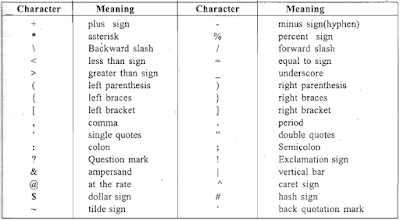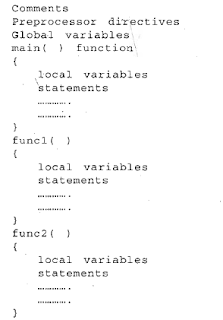Numeric Constant: Numeric constants consist of numeric digits, they may or may not have decimal point (.).
The
rules for defining numeric constants-
1.
Numeric
constant should have at least one digit.
2.
No
comma or space is allowed within the numeric constant.
3.
Numeric
constants can either be positive or negative but default sign is always
positive.
There are two types of numeric constants-
Integer constant
Integer constants are whole numbers which have no decimal point ( . )
Some
valid decimal integer constants are-
123
3705
23759
Some
invalid decimal integer constants are-
2.5 Illegal character ( . )
3#5 Illegal character ( # )
98
5 No blank. space allowed
0925
First digit can not be zero
8,354
Comma is not allowed'
Real (floating point) Constants:
Floating point constants are numeric constants that contain decimal point.
Some
valid floating point constants are-
0.5
5.3
4000.0
0.0073
5597.
39.0807
Character Constants:
Character
constant is a single character that is enclosed within single quotes.
Some
valid character constants are-
'9' 'D' '$' ‘ ’ '#'
Invalid character constants are-
'four' There should be only one character within quotes
"d" Double quotes are not allowed
"
No character between single
quotes
y
Single quotes missing
String Constants:
A string constant has zero, one or more than one character. A string constant is enclosed within double quotes (" "). At the end of string, \0 is 'automatically placed by the compiler.
"Kumar"
"593"
"8"
"A"
Symbolic Constants:
If
we want to use a constant several times then we can provide it a name. For
example if we have to use the constant 3.14159265 at many places in our
program, then we can give it a name PI and use this name instead of writing the
constant value everywhere. These types of constants are called symbolic
constants or named constants.
A symbolic constant is a name that substitutes for a sequence of characters
These
constants are generally defined at the beginning of the program as
#define name value
Here 'name' is the symbolic name for the constant, and is generally written in uppercase letters. 'value' can be numeric, character or string constant.
Some examples of symbolic constants are as-
#define
MAX 100
#define
PI 3.14159625
#define
CH 'y'
#define
NAME "Sam"
In the program, these names will be replaced by the corresponding values. These symbolic constants improve the readability and modifiable of the program.






